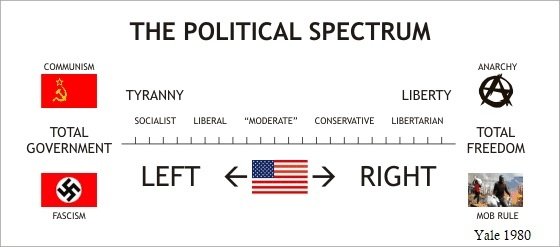In the context of identifying and classifying political ideologies, one must understand the differences between European and American perspectives. This understanding helps clarify misconceptions about terms like “fascism” and their association with right-wing or left-wing politics. Much like our prior conversation regarding terms like “democracy” vs. “republic,” this confusion arises from a misallocation of context.
Clarifying Terminology
Fascism: An authoritarian ultranationalist political ideology and movement characterized large government, dictatorial power, forcible suppression of opposition, and strong regimentation of society, the economy, and individual lives.
Left-wing: Associated with progressivism, advocating for social equality, government intervention in the economy and culture in the name of creating a more equitable society.
Right-wing: Generally associated with traditional liberalism, advocating for limited government, limited intervention in the economy, and the protection of individual liberties.
Brief History of Fascism in Europe
Fascism emerged in Europe in the early 20th century as a reactionary ideology in response to the perceived failures of liberal democracy and the threat of communism. This political movement is most notably associated with Benito Mussolini in Italy and Adolf Hitler in Germany. Fascism is characterized by its authoritarian ultranationalism, dictatorial power, forcible suppression of opposition, and strong regimentation of society and the economy.
Origins and Development
Italy:
- Fascism in Italy was pioneered by Benito Mussolini, who founded the National Fascist Party in 1919. Mussolini’s rise to power culminated in the March on Rome in 1922, which led to his appointment as Prime Minister.
- Mussolini’s regime emphasized the revival of Roman greatness, a totalitarian state, and the corporatist organization of the economy, where major sectors were controlled by state-run syndicates.
Germany:
- In Germany, Adolf Hitler’s National Socialist German Workers’ Party (NSDAP) rose to prominence by exploiting economic woes, political instability, and societal fears.
- Hitler became Chancellor in 1933 and swiftly established a totalitarian regime, focusing on Aryan supremacy, anti-Semitism, and militaristic expansion.
Collectivist Embrace
Left-Wing and Right-Wing Collectivism:
- Both fascist regimes in Italy and Germany exhibited strong collectivist tendencies, emphasizing the subordination of individual interests to the needs of the nation or race. This collectivist ethos was shared by various left-wing movements in Europe, particularly communism, which advocated for the collective ownership of resources and centralized economic planning.
- European right-wing collectivism, as seen in fascism, differed from traditional American right-wing ideologies. While American conservatism values limited government and individual liberties, European fascism involved significant state intervention and control over many aspects of life.
Comparison to American Ideologies:
- In Europe, the right-wing often endorsed state intervention and collectivism, albeit with a focus on nationalism and cultural unity, contrasting with left-wing emphasis on class struggle and economic equality.
- In contrast, American right-wing ideologies typically emphasize individualism, free markets, and minimal government interference. This divergence highlights a fundamental difference in how right-wing politics are conceptualized across the Atlantic.
Understanding these historical and ideological differences is crucial for accurately interpreting and classifying political movements and their impacts on society. This distinction sets the stage for comparing European and American political contexts more effectively.
European vs. American Politics
European Context:
- In Europe, fascism emerged as a reaction against communism, often characterized by authoritarian nationalism and state control over the economy.
- Europe’s political spectrum generally leans more left compared to the U.S., with greater acceptance of state intervention in social and economic matters.
American Context:
- American conservatism traditionally values limited government, individual liberty, and free-market capitalism.
- In the U.S., right-wing ideology emphasizes minimal state intervention and prioritizes personal freedom and economic independence.
Given these distinctions, applying European classifications of fascism as right-wing to American politics can be misleading. In the American context, where right-wing values emphasize limited government and individualism, both fascism and communism align more closely with left-wing ideologies due to their emphasis on state control.
The Misrepresentation of Conservative Values
As the progressive faction of the American left continues to shift the Overton window further left, there is a tendency to demonize conservative values and misrepresent conservative policies. This process involves promoting a narrative within their faction, using logical fallacies to construct a boogeyman of a “fascist right wing” that seeks to establish an authoritarian regime. This narrative misrepresents the true nature of American conservatism.
In American politics, what are often referred to as “conservative values” aligned with the values of traditional liberalism. This alignment primarily stems from classical liberalism, which emphasizes individual liberty, limited government, free markets, and the rule of law. These principles are central to many conservative ideologies today.
Classical liberalism emerged during the Enlightenment period and significantly influenced the founding principles of the United States. It championed ideas such as individual rights, private property, and free enterprise, which were seen as essential for a free and prosperous society. As a result, many values that conservatives uphold today, such as a preference for smaller government, individual responsibility, free-market capitalism, and a strict interpretation of the Constitution, are rooted in classical, or traditional liberalism.
Over time, the term “liberalism” evolved, particularly in the United States, where modern liberalism came to represent a greater focus on social equity, welfare programs, and regulatory measures. These values contrast with traditional liberalism, by advocating for more government intervention in the economy and in social issues to address inequalities and provide public services. Therefore, while contemporary political terminology can sometimes blur these lines, the core principles of traditional liberalism are indeed closely aligned with what are often considered conservative values in American politics.
Examples from the Media:
- Media Portrayals: Certain media outlets often portray conservative policies as inherently authoritarian or fascist, ignoring the core conservative principles of limited government and individual autonomy. For example, some articles in publications like The New York Times have compared Trump’s administration to fascist regimes, focusing on presenting rhetoric out of context to create a nationalistic or authoritarian tone without acknowledging the administration’s deregulation efforts aimed at reducing government intervention or the administration’s refusal to implement nationwide lockdown policies in favor of respecting state autonomy.
- Logical Fallacies: Ad hominem attacks and straw man arguments are frequently used to paint conservatives as villains, diverting attention from substantive policy debates. For instance, during the 2016 election, many commentators on platforms like MSNBC and CNN used ad hominem attacks against Trump supporters, defaming them as racist or fascist without addressing the reality of the economic and social concerns driving their political choices.
- Demonization Campaigns: High-profile figures and media campaigns often target conservative leaders, labeling them as fascists without substantive evidence, further entrenching the false narrative. An example is the repeated comparisons of Republican lawmakers to Nazis by figures like Alexandria Ocasio-Cortez in media coverage, which often go unchallenged and reinforce a simplistic and misleading dichotomy.
TL:DR
Understanding the divergent nature of European and American political ideologies is essential to clarify misconceptions about terms like fascism. In the American context, fascism does not align with conservative values of limited government and individualism. The portrayal of a fascist right wing aiming for authoritarianism misrepresents conservative policies and values. Recognizing these distinctions helps promote a more accurate and nuanced political discourse. In fact, the demonization tactics, misrepresentation of values, and violent rhetoric that we’ve seen coming from the left much more closely resemble tactics related to fascism and authoritarianism than anything we’ve seen on the right in the past ten years.
Read More
- Books:
- “Liberal Fascism: The Secret History of the American Left, from Mussolini to the Politics of Change” by Jonah Goldberg
- “The Road to Serfdom” by Friedrich Hayek
- “The Origins of Totalitarianism” by Hannah Arendt
- Articles and Essays:
- “The Myth of the Fascist Right” by David Ramsay Steele
- “Comparative Politics: Communism vs. Fascism” by various scholars
- Videos and Lectures:
- Lectures on political ideology by Jordan B. Peterson
- “The Political Spectrum: Communism, Fascism, and Democracy” by PragerU
- Websites:


Leave a Reply